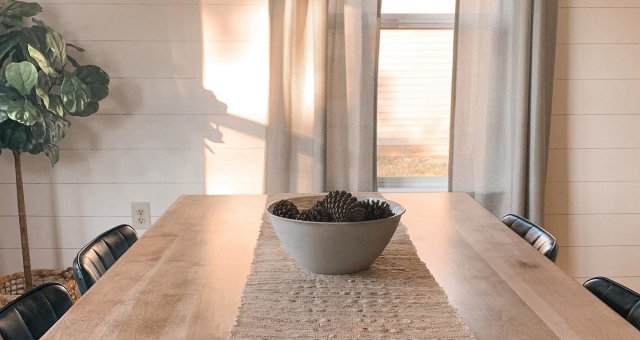Duvet vs Comforter
We all wish for an inviting and comfortable bedroom where we can find calm and a good night’s rest. A significant part of establishing this atmosphere is the room’s main feature: the bed — specifically, its bedding. Since the first thing you’ll probably notice when entering a bedroom is the bedspread, it’s worth spending some time determining just what kind of bedding covers are available, what their differences are, and what the pros and cons are of the various options.
What Is the Difference Between a Comforter and a Duvet?
When we examine the top layer we place on our beds, there are essentially two main options: a duvet and a comforter. Certainly, they’re similar — both are fluffy, thicker than a blanket, and are available in multitudes of colors, patterns, and styles. But how are they different?
Most notably, a comforter is a single piece of fiber-filled bedding, usually with some topstitching that prevents its fluffy contents from bunching up or moving around.
A duvet, on the other hand, is composed of two pieces: first, the duvet insert — also a fiber-filled piece of bedding — and, second, the duvet cover which encloses the insert. Typically, there is no top stitching on a duvet. It’s easier to think of a duvet cover as a giant pillowcase for the duvet insert, and as such, this bed covering can resemble a large, fluffy pillow.
When we compare a comforter and a duvet, we find one is not necessarily better than the other. They both have their advantages and disadvantages based on the features for which you’re looking.
Pros and Cons of a Comforter
The most obvious benefit of a comforter is that it’s a single piece of bedding and does not require the kind of assembly a duvet does. Some people find the chore of inserting a duvet insert into its cover to be an unnecessary extra step in the laundry/bed-making process, so a comforter, which does not require this step, is often seen as advantageous.
Another pro for comforters is that they usually have some sort of topstitching that keeps the internal stuffing in place, which prevents any potential bunching or lopsided coverage. This often gives comforters a finished look that is similar to a quilt, although quite a bit fluffier. Examples of such comforters can be found here, and an entire comforter and matching sheet set is always a beneficial purchase.
Some disadvantages of using comforters as your bedspread include their bulkiness when washing them. Especially for larger, king-size comforters, it is sometimes necessary to use a laundromat’s specialty-sized washers. Another disadvantage is a comforter’s tendency to go flat over time.
And finally, when compared to the versatile nature of a single duvet cover, a comforter doesn’t allow for an interchangeable look — once you commit to the color or pattern of your comforter, you cannot change it unless you buy another comforter.
Pros and Cons of a Duvet
The benefits of a duvet are plenty. The first is the ability to alternate the feel and tone of your bedroom by simply using a different duvet cover without having to purchase another insert. You can change the color, pattern, or theme of your bed covering with the turn of the seasons, or perhaps you just want to try a new look. Check out the variety of duvet covers available.
Another benefit of a duvet is its laundering process. Since the duvet cover, not the insert, requires the most necessary washing, it is easier to maintain. Plus, duvets were originally meant to be used without a top sheet and blanket (though you certainly can if you want). That amounts to fewer pieces to wash.
Duvets are not without their downsides, however. Though a duvet cover is easy to clean, it does require the added step of placing the duvet insert back inside its cover after each wash, which is a process many people find arduous and time-consuming. Additionally, unless your duvet has options to attach your insert to the interior corners of the duvet cover, there’s the potential for the insert to bunch up inside the cover.
A final note about a duvet is that it is an investment; you do have to purchase the two components— the duvet insert and its cover — separately.
How To Use a Duvet
Using a duvet is as easy as using any other layer of bedding. The difference, as mentioned above, is that a duvet is similar to an oversized pillow and pillowcase. One end of the duvet cover has a wide opening where you slip in the duvet insert. There are also usually buttons, snaps, ties, or a zipper at this opening to prevent the insert from slipping out of the cover.
It can sometimes be tricky to assemble the duvet insert into the cover, but here are six easy steps to get your duvet ready for your bed:
- Turn your duvet cover inside out and place it flat out on your bed.
- Slide your hands inside the cover so that each hand is holding the top two corners.
- Keep your hands inside the duvet cover and reach down to grab the insert’s top two corners, one in each hand.
- Hold these corners and flip the duvet cover right side out over the insert. You’ll probably have to shake it down a bit.
- Place the duvet back on the bed and finish by reaching inside the cover to make sure each corner of the insert is tucked into the duvet cover’s corners. Some duvet sets have ties or snaps to anchor and attach the insert’s corners to the cover’s corners.
- Once everything is aligned, button, tie, or zip it up, and your duvet is ready to use!
Can You Put a Duvet Cover Over a Comforter?
No hard and fast rule says that you can’t put a duvet over a comforter, but you’ll want to check their compatibility first. Are your comforter and duvet cover the same size? Both kinds of bedding come in standard full, queen, and king size. For example, you’ll want to make sure you’re not trying to use a full-sized comforter with a king-sized duvet cover — that would just look off-kilter!
Even if you are matching sizes correctly, try them on together and give it a good night’s sleep. Did the comforter move around or bunch up too much in the cover during the night? When your duvet-covered comforter is spread on your bed, does it look natural and tidy? When mixing and matching a duvet and comforter, you want its appearance to be as pleasing and satisfying as the sleep experience itself!
Comforter vs. Duvet vs. Quilt
With all this talk of bedding, especially bedspreads, it’s natural to wonder about quilts, which are also as common to bedrooms as comforters or duvets.
Quilts tend to be a bit thinner than your standard comforter or duvet and not nearly as bulky or fluffy. They can often be used in place of a blanket when layered with matching sheets but are not as commonly used as a comforter or duvet for top bedding. Sometimes this is because quilts are handmade and not necessarily designed to standard sizing. Also, quilts are often pieced together with many different fabric patterns, which doesn’t always make it easy to match the surrounding decor.
Bedding Takeaways
Now that you know the differences, as well as the pros and cons of your comforter or duvet options, you’re sure to find exactly what you want at Ashley furniture.





